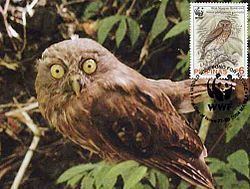Kingdom Animalia Order Strigiformes Genus Ninox Higher classification Ninox | Phylum Chordata Family Strigidae Scientific name Ninox philippensis Rank Species | |
 | ||
Similar Ninox, Cebu hawk‑owl, Camiguin hawk‑owl, Chocolate boobook, Negros scops owl | ||
Luzon hawk owl
The Luzon hawk-owl (Ninox philippensis) is a species of owl in the family Strigidae. It is endemic to the Philippines where it lives in forests. It is a brown and white mottled bird and males and females look much alike.
Contents
Description
The Luzon hawk-owl is one of the smallest of the owls in the Philippine hawk-owl complex. It has white eyebrow-like streaks above the eyes and the beak and a white moustache forming an x-shape on the head. It does not have tufts of feathers on its head resembling ears. The upper parts of all subspecies are brown and the wings are mottled with oval-shaped white spots. The tail is dark brown with narrow white stripes. The sides of the head are brown, the chin is a whitish colour, while the rest of the underparts are pale white with wide brown streaks which are more prominent on the breast. The underside of the tail is white. The chequered subspecies have these reticulated patterns on the underparts, on the head, the upper parts of the back and the wings. The feet are partially covered with feathers and are pale yellow. The beak is olive.
Systematics and taxonomy
There are three known subspecies:
Ecology
The Luzon hawk-owl can be found in forest areas up to about 1,800 m (5,906 ft) above sea level, although they mostly reside in areas below 1,000 m (3,281 ft). Its natural habitats are subtropical or tropical moist lowland forests and subtropical or tropical moist montane forests. The breeding season for this species starts around February and the nests can be found in hollow trees. It feeds on insects and small rodents.
Status
The International Union for Conservation of Nature (IUCN) uses the taxonomy classification before splitting the Philippine hawk-owl complex was suggested, so it does not have a separate assessment for the Luzon hawk-owl. However, the IUCN treating the complex as a single species report that these owls have a large range and that they are locally common within that range and the population size is believed to be stable. The owls face no particular threats, and as a result, the IUCN has listed the group as being of "Least Concern".
